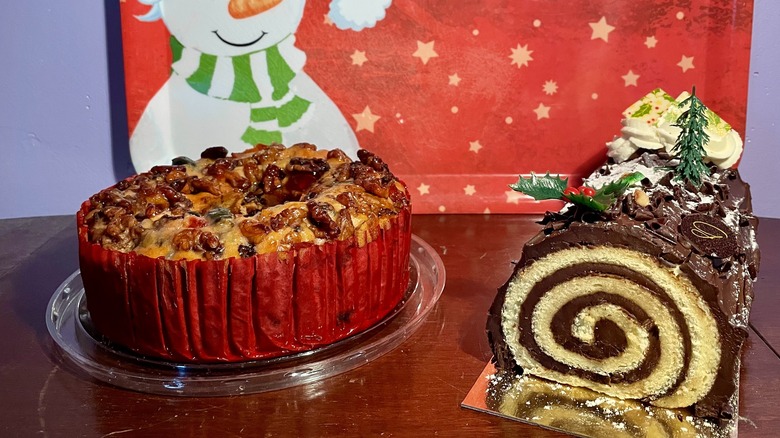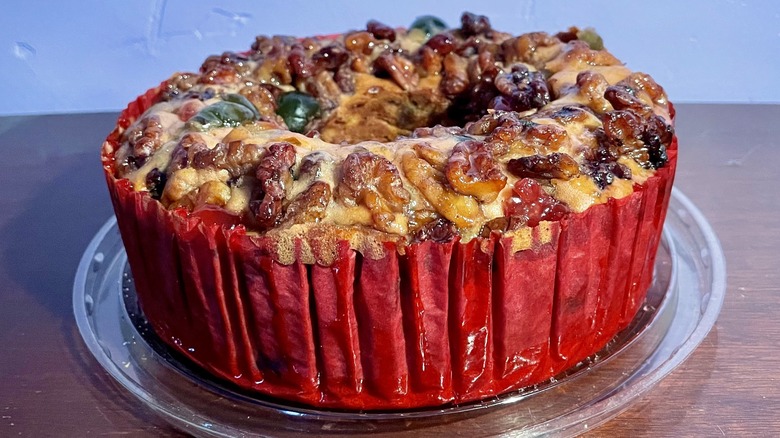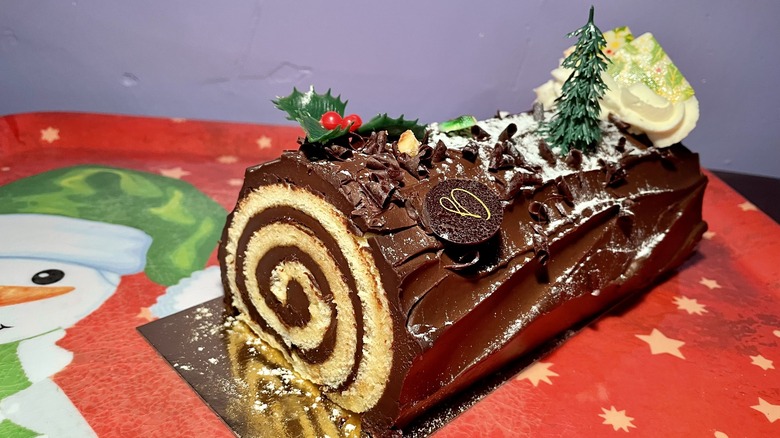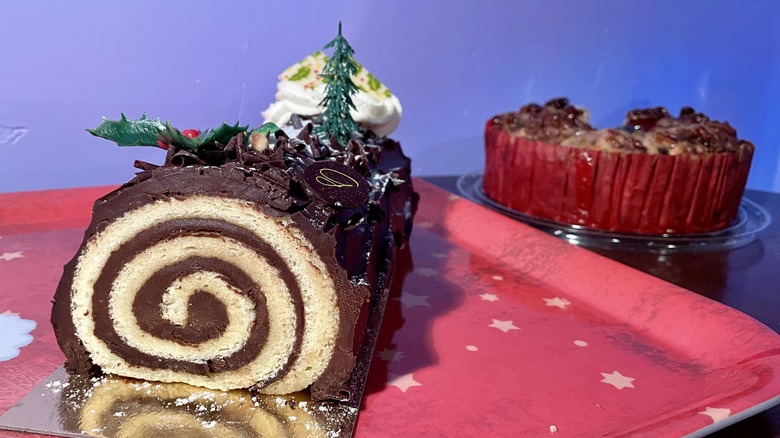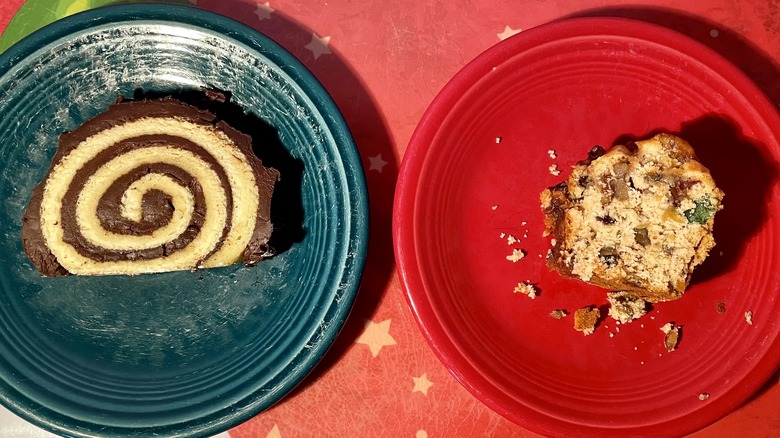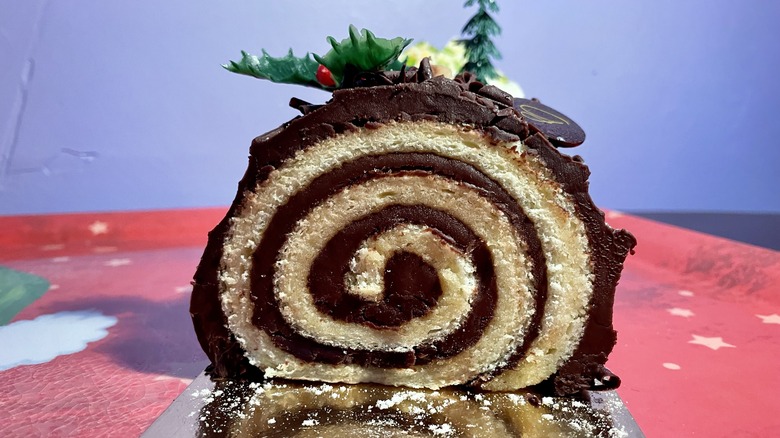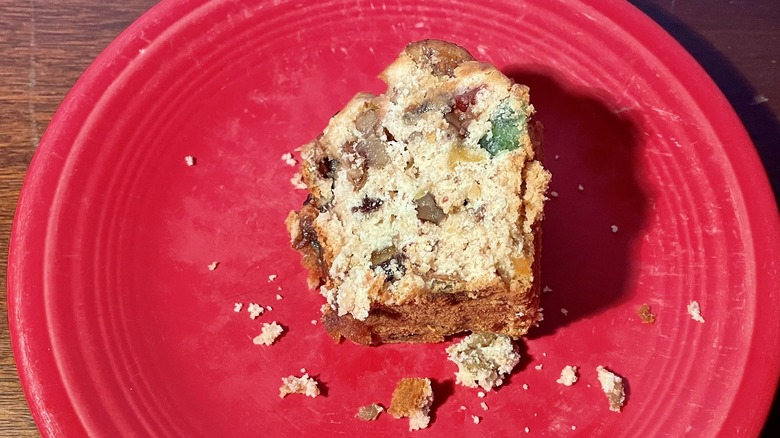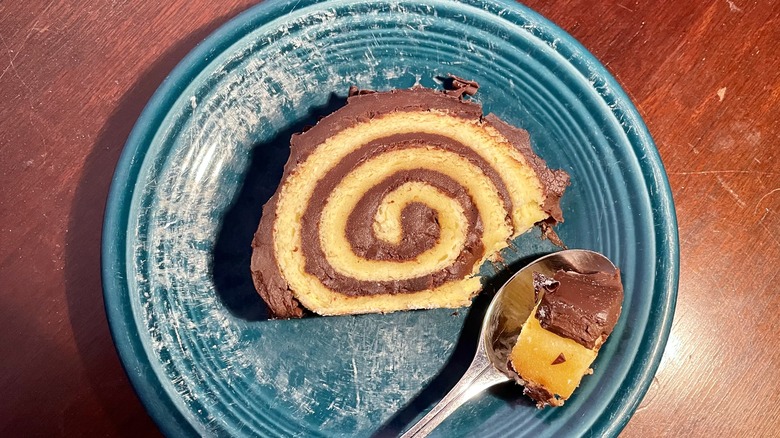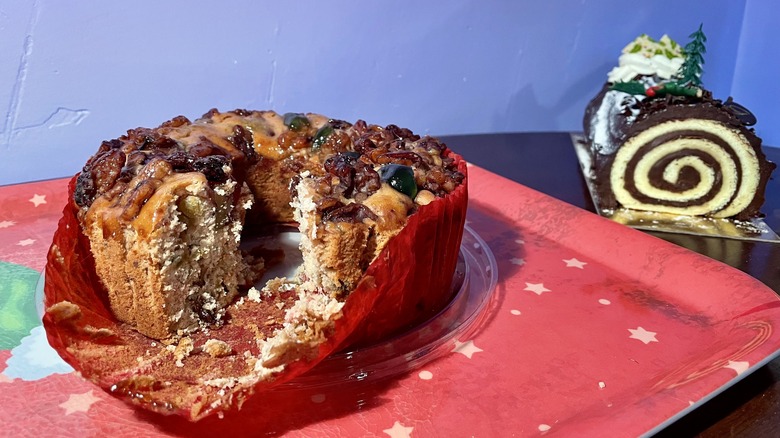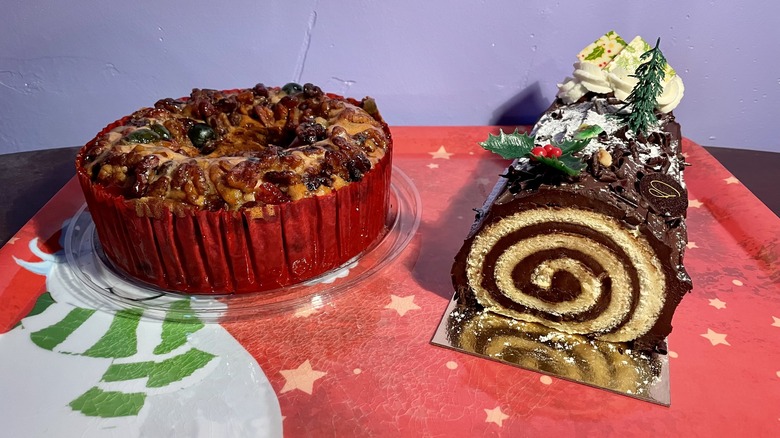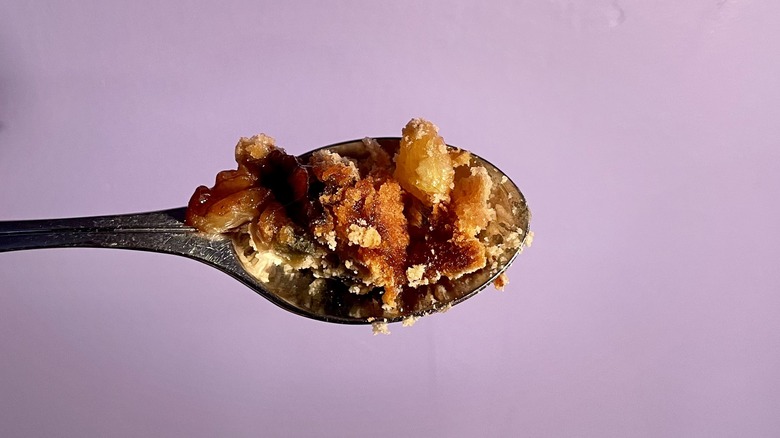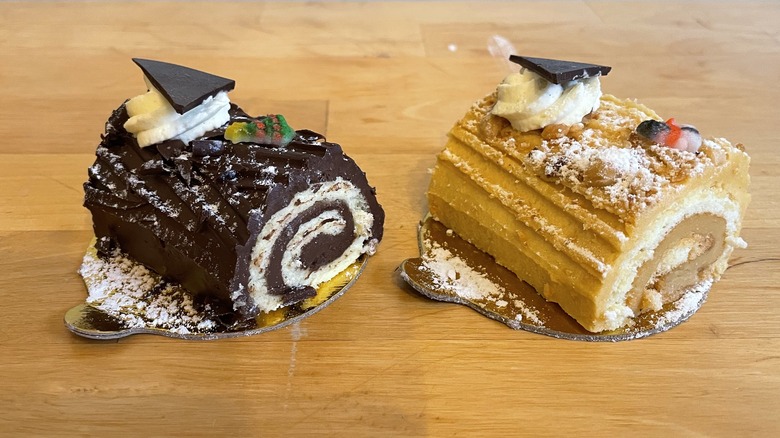Yule Log Vs Fruitcake What To Know About The Classic Holiday Cakes
Weddings and birthdays would not be complete without cake. Likewise, as people ring in the festive season, the holidays bring their own cake-based traditions. These are celebrated in different styles around the world, from stollen in Germany to black cake in the Caribbean. Cookies, candy canes, and pie all have their place in this season of indulgence, but a festive fruit cake or Yule log would really stand out as a centerpiece of the holiday dessert table.
Both of these cakes are steeped in the rich tradition that transcends borders and brings people together. That being said, they are surprisingly different. While they are both technically cakes, the way these desserts are made could not be more different. If you have ever wondered about these two confections, you have come to the right place. We will tell you everything you need to know in order to make your holiday table merry and bright.
Fruitcake
Fruitcake isn't just any kind of cake; it is a cake with a superpower: it lasts forever. Okay, maybe not forever, but it has a much longer shelf life than a standard cake. In fact, there is still a fruitcake that has been around since 1878.
Fruitcakes have existed in some form for hundreds of years and have become a traditional Christmas food in many countries. However, they look different depending on where you get them. In Italy, for example, panettone is a fluffy, sweet bread with dried fruit and nuts. Stollen from Germany is a dense Christmas bread filled with dried fruits and covered in powdered sugar. While both of these are holiday fruitcakes, we are going to be focusing on the British and American style fruit cake. This loaf-like cake is also baked with dried fruit and nuts and often soaked in alcohol. Just to make matters more confusing, holiday foods such as plum pudding and figgy pudding are also found in this category. These cakes have been part of the holiday tradition for a long time, though no one is quite sure why. It may have something to do with the use of preserved ingredients that would be available in the winter.
Yule Log
As the name suggests, the Yule log was created initially to celebrate Yule, the celebration of the winter solstice. As we all know, Christmas is not the only holiday in December, and while Yule and Christmas have become linked due to their timing, Yule is its own celebration with pagan roots.
This spawned the creation of the Yule log, a rolled cake decorated to look like its namesake, a wooden log. While you may be thinking, "What's so special about a rolled cake?", this isn't just any rolled cake. Yule logs are made from a delicate sponge and filled with a delicious cream filling. Chocolate is a popular cake flavor, though it can be made with pistachio, praline, or other flavors. The cakes are often textured on the outside to look like bark and can include a whole host of decorations like mushrooms made out of meringue and edible mistletoe. Fruitcakes may have the advantage of lasting longer, but Yule logs certainly go all-out on appearance.
How they became associated with Christmas
The different forms of fruitcake have been a part of the Christmas tradition for a shocking amount of time. In recent years, though, fruitcake has been much maligned and has become the butt of jokes. The culprit is thought to be the American postal system. In the early 1900s, fruitcake was touted as the perfect mailable gift. For a time, this led to a huge upswing in fruitcakes as part of the Christmas tradition. The problem is this led to the mass production of cake that was, first and foremost, mailable (not tasty). Mass production took its toll, and much like strawberries grown for shipping and not eating, fruitcakes became flavorless, dry, and sad.
For the Yule log, Christmas took over as the more popular holiday, but certain traditions stayed around. Part of the traditional ways to celebrate Yule included burning a log or a whole tree, which makes sense given the time of year. However, over time, this evolved from burning a whole tree, which could easily be a fire hazard, to a decorative cake made for the Christmas table. The cake goes by different names depending on the country; the French call it a bûche de Noël, which translates to "Christmas Log."
Ingredients
The components for the two cakes are wildly different, yet somehow, both involve long lists of ingredients. Fruitcakes contain large amounts of dried fruits and nuts chopped into small pieces. Citrus zest is often incorporated to provide an extra punch, while spices are also mixed in. The result is a spicy fruit cake. Of course, traditionally, there is one additional key ingredient to complete the concoction: booze.
The Yule log takes all the things that make a cake and then throws in some more. There is butter, flour, sugar, vanilla, cream, cocoa powder, and chocolate (if you're making a chocolate version). This may sound like less, but the thing is, you use many ingredients multiple times for different components. The eggs, for example, need to be separated into yolks and whites. The whites are used to make meringue mushrooms and are often whipped and used to make the sponge cake light and fluffy. And this doesn't even take into account the additional decorations that have become such a part of this holiday dessert.
The baking process
The baking process of the fruitcake is much simpler than the Yule log. Once you have all your ingredients prepped, it is a simple matter of mixing everything together and baking in loaf plans. The main thing is to remember the alcohol. This is part of why fruitcakes have historically lasted for so long. The dried fruit can be soaked in rum, brandy, or whiskey. This helps plump up the fruit and add an extra flavor. Or you could take a page out of the British Christmas cake book and literally douse the cake in alcohol every two weeks, aging it for about three months before serving.
The Yule log is different. While the fruitcake is robust and hearty, the Yule log is delicate, notoriously time-consuming, and challenging. Not only are you making a more complex cake, which often requires whipping egg whites and carefully folding in your ingredients, but the baker must then get the cake rolled with its filling without cracking the log, which is not an easy task. Finally, there are the decorations, which you can make, buy, or both. And in the end, the cake must be consumed within a short timeframe, or the whole thing can go stale and become unappetizing.
Where they can be purchased
If you don't want to make either of them, there are options to buy the cakes in-store. Given the history, it should be unsurprising that buying a fruitcake is easier than buying a Yule log. National stores such as Walmart and Williams-Sonoma sell them in stores. They can also be ordered online from outlets such as Harry & David and shipped directly, which drives home the Christmas tradition.
Yule logs are more difficult, though. Outlets such as Williams-Sonoma do sell bûche de Noël, but not in-store. They must be shipped. If you are looking to get one in a brick-and-mortar location, you will likely be heading to an independent bakery, and not a grocery store. You may also have to preorder them, as due to their delicate nature, they are not made en masse or sold off the shelf. Even places such as Fresh Market have limited time frames when they are sold.
Sweet and delicious
Both the Yule log and fruitcake are desserts and, as such, do not have much in the way to offer as nutrition goes. Obviously, depending on who made each cake, the nutritional information for each can vary, so for consistency, we used our own recipes to compare the nutritional information for each.
With all that delicious filling and covering, the Yule log really packs in the sugar and calories, coming in at over 500 calories per serving and over 50 grams of sugar. By comparison, the fruit cake has 328 calories and 38.9 grams of sugar. Likewise, the Yule log has 33 grams of fat, and the fruitcake has just nine.
The Yule log may come out richer, but it does have one potential advantage: its lack of alcohol. For people trying to avoid fruitcake, which, as we've discussed, can be soaked in alcohol, the Yule log is the cleaner option.
How much they cost
Depending on if you are buying or making your holiday dessert, the cost of each cake can vary greatly.
From our experience, buying a Yule log was far more expensive than buying a fruitcake. This was partially due to the fact that when you buy a fruitcake, you can buy it at Walmart, while a Yule log has to come from a specialty shop. Since Yule logs are so labor intensive, the price tends to be higher.
However, if you are making them, the situation reverses. Since Yule logs are more labor intensive but involve fewer ingredients, many of which can be purchased easily and somewhat inexpensively, you can make a Yule log without spending too much money. You may even have most or all the ingredients in your house.
Fruitcake is a different story. Dried fruit and nuts are not cheap. If you are following our recipe, you would need to buy five different kinds of dried fruit, including several citrus fruits, nuts, and rum. And none of these are particularly cheap. Additionally, you often can't buy the exact amount you need for just one cake, so you may have to buy a larger container of each, even if you aren't going to use them in the recipe.
Two Christmas looks
It is hard to compare the look of Yule logs and fruitcakes as they are so different. Fruitcakes can have frosting but are more commonly an unadorned loaf or ring. Because of the spices, the cake base offers a golden or brown hue, similar to banana bread. This is then speckled with multicolored dried fruit and nuts. It is simple and unintimidating.
The Yule log, though, is practically a work of art first and a dessert later. The decoration is part of what separates the Yule log from other rolled desserts—using edible designs to embellish the log base to make it feel like a rustic and almost ethereal outdoor scene. Then it is even dusted lovingly with powdered sugar like a blanket of snow. The fruitcake offers a more rustic and homey image, while the Yule log is elegant and precise at its finest. This does not mean that one is necessarily better than the other; it is just that they offer two different aesthetics.
How fruitcakes taste
The thing with fruitcakes is that the taste changes wildly based on who makes them. Not only do the spices, nuts, and fruits change, but the quality of those ingredients can vary, which makes all the difference. The fruitcake pictured above is from a big retailer. To put it delicately, it does not taste like a homemade fruitcake. Instead of using quality dried fruits, these are artificially colored and flavored fruits, soaked in what appears to be corn syrup, not rum. On the other hand, a homemade fruitcake will offer a lightly spicy flavor, which plays off the burn from the alcohol-infused fruit and cake.
Instead of being fluffy and light, the texture is dense and crumbly, again closer to resembling the texture of banana bread than that of a birthday cake. The nuts and dried fruit add bursts of bright flavor, along with an interesting textural shift. Made correctly, fruitcake will not be dry, a common complaint. Instead, it should offer enough moisture to make it palatable.
How Yule logs taste
The taste of Yule logs can also vary, specifically based on flavor. The most common combination in the United States is a chocolate and vanilla yule log, which is what we will use for this description.
Yule logs tend to go bad fairly quickly. However, a fresh Yule log is light, creamy, and rich. The sponge is moist and supple. It has to be, as otherwise, the cake would crack, not only causing it to be ugly but less tasty. The filling and shell help to preserve this moisture and prevent it from drying out like a day-old slice of cake.
The filling is light and creamy. Usually made of whipped cream, cream cheese mascarpone, or even a chocolate filling, the inside can offer a light tang as well but will never be overly dense. A fork should slide right through the cake. The outside shell is not crunchy but soft, such as a chocolate ganache, once again keeping everything light and delicate. Where fruitcake offers multiple textures, the yule log is predominantly smooth.
Finally, not all the toppings on a Yule log have to be eaten, but if you do, that is where some additional texture comes in. Meringue mushrooms, in particular, offer a sweet crunch before melting in your mouth, leaving just a light flavor that pairs with the rest of the cake.
